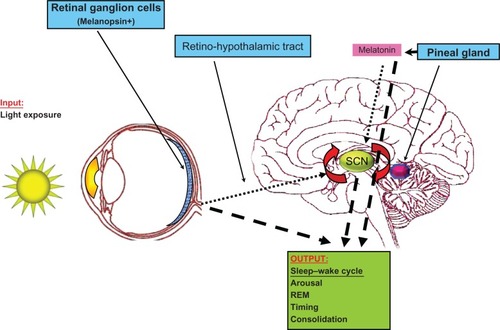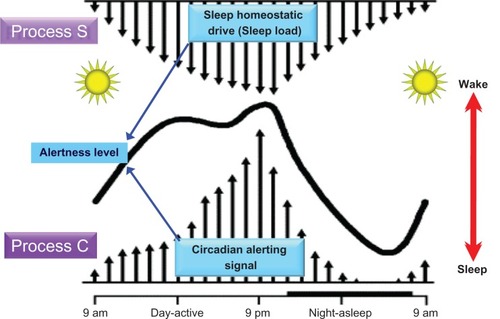Figures & data
Figure 1 The master clock in the suprachiasmatic nucleus (SCN) controls the timing of the sleep–wake cycle as well as promotes arousal, REM sleep, and sleep consolidation. Light resets the oscillations in the SCN through a mechanism involving melanopsin-containing retinal ganglion cells that project directly to the SCN via the retino-hypothalamic tract. Through an indirect pathway, circadian information reaches the pineal gland where the hormone melatonin is produced, which also can shift the phase of oscillations in the SCN. Both melatonin and neural information from retinal ganglion cells can also directly act on the sleep–wake system itself. Thus, light input and the circadian system work together to modulate properties of the sleep–wake cycle. The thin, dotted arrows represent the input pathways directly connected to the oscillatory central pacemaker in the SCN (denoted by rotating arrows). Bold-dashed arrows represent the different output pathways affecting the sleep–wake cycle. Both light and melatonin comprise aspects of the central circadian input pathway as well as the output signal controlling sleep–wake behavior.

Figure 2 Two processes govern the daily expression of the sleep–wake cycle in humans. Process S represents a homeostatic sleep pressure that accumulates in a nonlinear progression from the time of last sleep episode. With a subsequent sleep episode, the signal strength representing Process S decays at an exponential rate. Juxtaposed against Process S is Process C, which in this case is represented by a circadian alerting signal. Process C follows a nearly sinusoidal pattern, repeating independently of sleep episodes. Sleep and wakefulness are only maintained in a consolidated fashion when the signals from Process S and Process C are appropriately aligned.
Copyright © 2005. Adapted with permission from Kryger MH, Roth T, Dement WC, eds. Principles and Practices of Sleep Medicine. Philadelphia, PA: WB Saunders; 2005.
